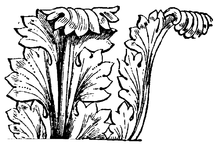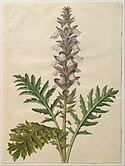Akanthus (Ornament)



Akanthus (Endung latinisiert) oder Akanthos (altgriechisch ὁ ἄκανθοςho akanthos „der Dornige“), häufig auch Akanthuswerk, ist die archäologisch-kunsthistorische Bezeichnung für den Typus eines Ornaments, das die Gestalt der Blätter der gleichnamigen Pflanzengattung in stilisierter Form aufgreift.
Die Natur als Vorbild: Das Akanthus-Blatt
Das distelartige Akanthus-Blatt ist ein wiederkehrendes Motiv in der Ornamentik. Eine Reihe aus Akanthusblättern fügt sich zu einem Akanthusfries. Kreisförmig symmetrisch angeordnete Akanthusblätter bilden eine Akanthusrosette. Eine aus Akanthusblättern zusammengesetzte Ranke heißt Akanthusranke. Dies ist eine freie künstlerische Erfindung, da der natürliche Akanthus keine Ranken treibt, ebenso wenig wie Blumen oder Kelche, die in die Darstellung eingebunden sein können.[1]
Geschichte und Vorkommensarten
Das Akanthusornament wird bis heute als Schmuckwerk eingesetzt. Je nach Stilepoche variieren die Darstellungsformen. Die frühesten Zeugnisse stammen aus dem 5. Jahrhundert v. Chr.: Das Akanthusblatt ist ein charakteristisches Element der korinthischen Kapitelle.
In Zierarbeiten des Barock erlebte es eine weitere Blüte. Allerdings spricht die Literatur vom 16. bis zum 18. Jahrhundert von Akanthus nur im Zusammenhang mit Kapitellen und verwendet bei anderen Erscheinungsformen des entsprechenden Ornaments den Begriff Laubwerk oder Lauber. Im Frankreich des 18. Jahrhunderts − besonders in der Zeit der Régence − wurde die florale Form häufig mit Bandelwerk verbunden, einem Flächenornament, bei dem die Ranken durch mit Blüten verzierte Linien ersetzt waren. Dies brachte den Sammelbegriff Laub- und Bandelwerk hervor.
Akanthus-Verzierungen finden sich in der Architektur an Säulen, Decken und anderen Gebäudeteilen, aber auch als Rankendekor (Laubwerk bzw. Blattwerk)[2] in der Buchmalerei.
Akanthusaltäre gibt es in Böhmen sowie in der Oberpfalz − dort beispielsweise in den Kirchen von Auerbach, Hemau, Reuth, Poppenreuth und Thumsenreuth. Die wuchernden vergoldeten Ranken umrahmen jeweils Bild- und Figurenmotive. Im Unterschied zu vielen anderen Altären ergibt sich dadurch ein sehr flächiger Gesamteindruck.
Eine frühe Form der laubförmigen Ornamentik ist im Bamberger Dom am Sockel des Bamberger Reiters, der in der ersten Hälfte des 13. Jahrhunderts geschaffen wurde, anzutreffen. Eine Besonderheit bildet das riesige Blatt unter den Vorderhufen des Pferdes, aus dem ein menschliches Gesicht als Blattmaske hervortritt.
Siehe auch →Blattwerk.
- Ornamentstich, hier ein Blatt von Dietrich Meyer, um 1700, gaben den Kunsthandwerkern Vorlagen an die Hand.
- Der Akanthusaltar der katholischen Kirche St. Katharina in Reuth gilt als Werk Johann Christoph Windischs.
- Vierzehn-Nothelfer-Altar in der 1935 erbauten Katholischen Pfarrkirche von Thumsenreuth. Der jüngste Akanthusaltar der Oberpfalz ist ein Werk von Sigmund Windisch.
- Kanzel in der St. Nikolai in Berlin-Spandau mit Akanthus-Schnitzereien, im späten 17. Jahrhundert von einem unbekannten Meister geschaffen.
Das Ornament wurde in der Neuzeit auch häufig auf Möbeln, in der Innendekoration, auf Silberarbeiten, und als Ziermotiv auf Waffen verwendet. Ebenso wird bis in die heutige Zeit bei Rangabzeichen auf entsprechende Formen zurückgegriffen.
Akanthus auf Porzellan
Der Bildhauer und Modelleur Dominik Auliczek entwickelte in den Jahren 1792 bis 1795 im Auftrag des bayerischen Kurfürsten Karl Theodor nach dem Geschmack des beginnenden Klassizismus ein absolut neuartiges Service im Louis-seize-Stil. Die Stücke des Perl-Services hatten erstmals in der Geschichte der europäischen Porzellanherstellung keine runde, sondern eine zwölfeckige Form. Einzelne in ihrer Funktion besonders hervorgehobene Teile, wie Tassen, Terrinen, Anbieteschalen, sind darüber hinaus mit plastischem Akantus verziert. Dieses Service war bis zum Beginn des 20. Jahrhunderts dem Hause Wittelsbach vorbehalten. Seitdem die Kinder von König Ludwig III. und Erzherzogin Marie Therese es 1918 als Geschenk zur goldenen Hochzeit ihrer Eltern fertigen ließen, ist es auch als das Bayerische Königsservice bekannt. Den Namen Perl trägt es wegen der Umrandung jedes Objekts mit einem feinen Perlstab.[3]
Einzelnachweise
- ↑ Franz Sales Meyer: Systematisch geordnetes Handbuch der Ornamentik zum Gebrauche für Musterzeichner, Architekten, Schulen und Gewerbetreibende sowie zum Studium im allgemeinen. 8. Auflage. Seemann, Leipzig 1911, S. 50, urn:nbn:de:gbv:wim2-g-2252141.
- ↑ Doris Oltrogge, Solange Michon und Robert Fuchs: Laubwerk - Zur Texttradition einer Anleitung für Buchmaler aus dem 15. Jahrhundert. In: Würzburger medizinhistorische Mitteilungen 7, 1989, S. 179–213; hier: S. 180 und 183.
- ↑ Perl. Website der Porzellanmanufaktur Nymphenburg, abgerufen am 27. April 2017.
Literatur
- Loretta Vandi: La trasformazione del motivo dell’acanto dall’antichità al XV secolo : ricerche di teoria e storia dell’ornamento. Bern 2002, ISBN 3-906767-76-0.
- L’Acanthe dans la sculpture monumentale de l’Antiquité à la Renaissance: [actes du colloque tenu du 1er au 5 octobre 1990 à la Sorbonne]. Paris 1993. ISBN 2-7355-0280-5; ISBN 2-85944-240-5.
- Alois Riegl: Stilfragen: Grundlegungen zu einer Geschichte der Ornamentik. Berlin 1893. (Nachdruck 1985)
- Günther Irmscher: Akanthus: Zur Geschichte der Ornamentform. In: Barockberichte. Bd. 26/27, 2000, S. 461–532.
- Franz Sales Meyer: Handbuch der Ornamentik. Tosa, Wien 2002, ISBN 3-85492-638-3, S. 46–51. (Nachdruck der 12. Auflage, Leipzig 1927)
- Hans Koepf: Bildwörterbuch der Architektur, 2. Auflage; Alfred Kröner Verlag, Stuttgart 1985, ISBN 3-520-19402-3, S. 7.
Weblinks
- Dienstgradabzeichen eines Landespolizeidirektors der österreichischen Polizei mit Akanthusornament.
- Akanthusmotiv in der Silberschmiedekunst: Der Lomellini-Krug, 1621–22.
- Akanthusmotiv auf einer englischen Tapete von 1875, Design: William Morris.
- Akanthusmotiv als Waffenschmuck: Entwurf für den Handschutz eines Nierendolches von Hans Holbein dem Jüngeren, 1536–38.
Auf dieser Seite verwendete Medien
Design for a guard of a ballock-dagger with top mount of the scabbard into which the knife and bodkin could have fitted. Pen and black ink with grey wash on paper, 7.3 × 7.1 cm, British Museum, London. "The ballock-dagger was named after the rounded forms at the base of the grip, ornamented here with two crouching men. A knife and bodkin, useful for cutting up food, were sometimes carried alongside a dagger or sword and fitted within the scabbard. Holbein has shaped the pommels and guards of these highly finished designs from a variety of motifs in his repertoire, fitting grotesque heads, musicians, acanthus leaves, scaly tnetacles and rams horns with flowing ease into the required forms of the dagger hilts. The designs are similar to the ceremonial dagger worn by Henry VIII in the cartoon for the Whitehall wall painting and suggest the design of such weaponry was among Holbein's tasks as a court artist." (Foister, p. 88.)
Akanthusaltar in Reuth bei Erbendorf, Baern
Autor/Urheber: PetrusSilesius, Lizenz: CC BY-SA 3.0
Kanzel der St.-Nikolai-Kirche in Berlin-Spandau
Autor/Urheber: Dmicha (Diskussion) 09:41, 26. Dez. 2013 (CET), Lizenz: CC BY-SA 3.0 de
Akantusblatt im Vergleich mit Säulenkapitell
Rank patch of the Austrian Federal Police (2015)
Ornamentstich mit Akanthus-Laub. Dietrich Meyer d. J., Ende des 17. Jahrhunderts. Kupferstichkabinett Berlin
(c) art_traveller, CC BY-SA 2.0 uk
The Lomellini ewer
1621-22
Probably by Giovanni Aelbosca
Italian, Genoa
Bearing town marks for Genoa for 1621 and 1622
Silver, cast, chased and embossed
Silversmith\'s mark: G A over B, probably for Giovanni Aelbosca, Belga, the basin inscribed 1621
The vase shaped ewer is supported on a circular foot with a square plinth. This foot is cast, formed of three highly stylised dolphins, alternating with grotesque bearded faces with their rising tails supporting a compressed knop. The lower part of the body is chased and embossed with alternate acanthus and palm leaves, and the centre with scenes of a Grimaldi general giving orders outside his tent and leading his troops into a combined sea and land battle. The flags flown by his troops are the Grimaldi standard and the Habsburg Saltaire (i.e. the Spanish flag). The shoulder of the ewer is embossed with a frieze of seamen, putti and prisoners. A baroque scroll shield of arms, divided “per fess”, (without tincture) is applied to the front. The neck, which is cast, is composed of two crouching satyrs at the front and a grotesque female demon supporting the large convoluted shell lip. The handle is cast as a double tailed triton wrestling with a satyr above and behind him; it rises from a grotesque beaked mask applied to the shoulder and attached to the shell lip by a stylised canine face.
This large ewer is paired with a basin and together they were originally part of a set of six. They were made in 1621 to 1622 and originally belonged to the wealthy and powerful merchant Lomellini family of Genoa. The Lomellini arms appear on the front of the ewer and the centre of the basin, and experts had previously thought that they were commissioned by a member of that family.
Somewhat confusingly, however, the ewer also bears the arms of the Grimaldi family. Furthermore, the event commemorated on both ewer and basin is thought to be the Battle of the Po (1431), in which Giovanni Grimaldi, Prince of Monaco, joined the Visconti of Genoa in their struggle against the Venetians. Four episodes from this battle are depicted on the rim of the basin, and the story is then continued on the body of the ewer and the well of the basin.
It has been suggested that the goldsmith may have used drawings by Lavazzo Tavarone (1556-1641), who worked on frescoes in the Palazzo Grimaldi. It is also possible that this ewer and basin were commissioned by the Grimaldi family and entered the collection of the Lomellini family at a later date.
Both pieces bear the mark of Genoa but were probably the work of a Flemish goldsmith, Giovanni Aelbosca Belga. It was not unusual for Flemish goldsmiths to be working in Genoa at this time as a large colony of Flemish artists also resided there in the early 17th century.
Autor/Urheber: Der ursprünglich hochladende Benutzer war Weissenstein in der Wikipedia auf Deutsch, Lizenz: CC BY-SA 3.0
Der Vierzehn-Nothelfer-Altar in der Katholischen Kirche un Thumsenreuth Foto: Harald Stark, 2004


















